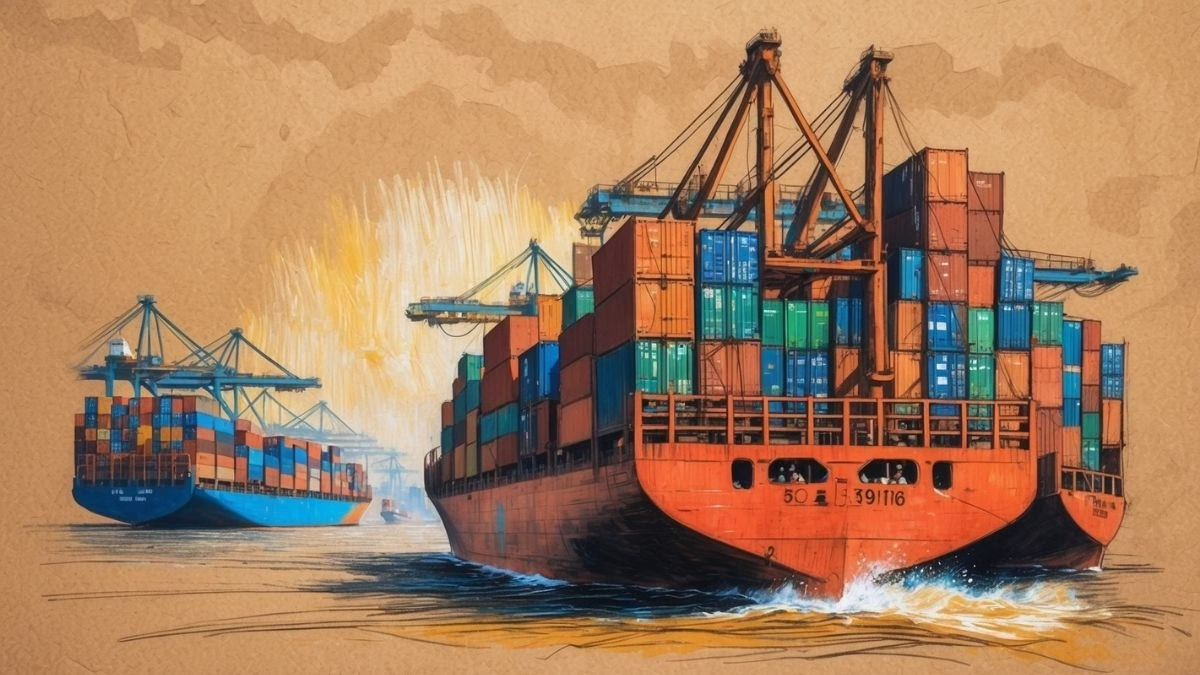Audio Episode
Transcript: Click to open
Ever looked at that new phone, maybe, or those, uh, exotic spices and wondered about their epic journey? How they get across continents? How does a single document act as, like, the unbreakable key to a safe for cargo worth millions? Mm-hmm. And why on earth might you need a specialized travel agent for something as, well, seemingly simple as a pair of shoes? It’s funny you put it like that, but yeah. We’re about to pull back the curtain on the often hidden, surprisingly complex and utterly essential world of global trade.
It really is essential. Get ready to understand how a pair of exquisite leather shoes from Brazil finds its way to a chic boutique in Japan, and the critical language, the terms, that make this whole global ballet possible. Welcome to a new introduction to a learning quiz from English Plus Podcast.
What you’re gonna listen to is to help you ace the quiz, but if you prefer to attempt the quiz right away, you can do that, because we have added hints and feedback for every option, and that’s what makes it a learning quiz and a fun one, if you ask me. But now let’s talk a little about what you may learn from this quiz. All right, let’s, uh, let’s unpack this.
Imagine a skilled artisan in Brazil, right, known for crafting these incredible leather shoes. Top quality stuff. Exactly.
And they’ve just received a pretty significant order from a new high-end retailer way over in Japan. OK, new relationship, big distance. Yeah, this isn’t just popping down the road.
We’re talking oceans, different languages, legal systems, the works. So the big question is, how do we even begin to get those beautiful shoes from a factory floor in Brazil all the way to a store shelf in, say, Tokyo? And what’s really fascinating here, or maybe critical is the better word, is that navigating this complex global landscape demands, well, absolute mastery of a very specific language. The language of trade.
The language of international commerce. Yeah. It’s more than just knowing the terms, you know, it’s understanding the precise responsibilities, the risks, the strategic implications each one carries.
Frankly, it’s the difference between a smooth, profitable deal. The dream. And a catastrophic logistical tangle that could cost you your entire profit margin or, you know, even worse.
That’s a critical insight, because right at the start, like you said, new buyer. There’s an inherent trust issue, isn’t there? Absolutely. Huge.
The Brazilian seller wants assurance they’ll get paid. Right. And the Japanese buyer wants confidence they’ll actually receive their shoes.
Of course. Both sides are exposed. So how do these two parties, thousands of miles apart, establish that fundamental financial trust? How do they bridge that gap? This is where the letter of credit or LC, as it’s usually called, becomes just an indispensable tool.
OK, LC. Think of it not just as a financial guarantee, though it is that, but as a strategic enabler. The buyer’s bank essentially issues this letter, this promise, pledging to pay the seller as long as the seller presents a very specific set of documents, documents proving they’ve fulfilled their end of the bargain.
So proof of shipment, basically. Exactly. Proof the goods were shipped exactly as agreed.
This mechanism, it just de-risks new international partnerships. It unlocks opportunities that would otherwise be far too precarious, just too risky. Honestly, without it, many high value cross-border transactions, they just wouldn’t happen.
Period. Wow. So it’s not just a handshake.
It’s more like a robust financial security blanket, makes global trade accessible even for new relationships. OK, so the payment mechanism is sorted, more or less. What’s the very next document the Brazilian seller needs to start preparing for the actual physical shipment? OK, money’s looking good.
The first essential document, really the foundational piece, is the commercial invoice. Commercial invoice. Sounds official.
It is. This isn’t just your standard bill. It’s the official declaration of the sale.
It details the goods, their quantity, their value, the terms of sale, all of it. And why is that so critical? It’s absolutely crucial for customs clearance, for calculating duties and taxes and, well, for the financial transaction itself. Any mistake here, any discrepancy can cause massive delays down the line, huge headaches.
Then following right on that, you’ll need the packing list. OK, packing list, different from the invoice. Yeah, quite different.
While the commercial invoice tells you what you’re selling and its value, the packing list details how it’s all packaged up. Ah, the specifics. Exactly.
It precisely itemizes the contents of each box. For our shoes, that would mean, you know, how many pairs of size 8, how many size 9, what type of leather, carton dimensions, weight. That level of detail.
And that’s important. It’s vital for the buyer, first off, to verify the order when it arrives. Did they get what they paid for? And it’s also essential for customs officials to quickly and accurately inspect the shipment if they choose to.
Imagine trying to find one specific pair of shoes in a container with a thousand boxes without one. Nightmare. Yeah.
OK, now this next document, the certificate of origin. It sounds a bit like a passport for the shoes. Huh.
That’s a great way to put it. But why is its nationality, so to speak, so critically important in this complex world of international trade? You’re spot on. It’s effectively the shoes birth certificate proving they were genuinely made in Brazil.
And this this seemingly simple fact has enormous strategic implications. How so? Well, many countries have free trade agreements, right? These agreements can drastically reduce or sometimes even eliminate import taxes. Those are tariffs or duties on goods coming from specific nations.
OK, so a trade deal between Brazil and Japan, maybe. Precisely. If such an agreement exists for leather shoes, this certificate proves the goods qualify.
Without it, our Japanese buyer would likely pay significantly higher taxes, making the shoes more expensive for their customers. Exactly. Less competitive, maybe even unprofitable in their market.
So it’s a key determinant of the final landed cost. So often the difference between a product being competitively priced or just, you know, gathering dust on a shelf. It really makes you think, doesn’t it, about how many unseen factors influence the price tag on something you just pick up in a store.
Absolutely. There’s a whole world behind that price. OK, so we’ve got our beautifully crafted shoes packed up, all our essential documents, the invoice, the packing list, the origin certificate prepared and verified.
Who do we actually call now? Who orchestrates the complex journey from a factory in Brazil across the vast ocean to Japan? That’s precisely when you bring in a freight forwarder. Freight forwarder. OK.
Now, these aren’t the shipping lines themselves or the airlines. They don’t own the big ships or planes. Rather, they are the logistics maestros, the orchestrators of cargo movement.
They are experts in navigating the, frankly, labyrinthine world of global shipping. So they handle the details. All of them.
They book the space on the ship or plane. They handle the myriad of documents, arrange customs clearance at both ends, manage the whole journey from your factory door. Right to the final destination.
Think of them as your outsourced shipping department. A travel agent for cargo, like we teased. Exactly.
A very specialized, very important travel agent for your cargo. They handle everything so you don’t have to worry about it. That makes perfect sense.
But what if our Japanese retailers order, while maybe substantial for them, isn’t quite large enough to fill an entire shipping container by itself? That sounds like it could be incredibly expensive paying for all that empty space. You’ve hit on a really common challenge, especially for smaller businesses. And that’s exactly where groupage comes in.
Groupage. Yeah, groupage. Or it’s often called less than container load, LCL.
It’s a brilliant solution, really. The freight forwarder consolidates multiple smaller shipments from different companies, all heading in the same general direction. They combine them.
Precisely. They put them all into a single container. So our shoes might share space with, I don’t know, auto parts from another Brazilian exporter or maybe coffee beans from a different region heading to Japan.
So you share the cost of the container. Exactly. It’s a highly cost effective way to leverage economies of scale.
It makes global trade accessible and affordable, even for businesses that aren’t shipping massive quantities. It’s basically, yeah, sharing the ride for your cargo. That’s clever.
A really clever way to optimize costs. OK, so we’ve got the shoes, the documents, the freight forwarder is arranging things, maybe using groupage. But who’s ultimately responsible for what at each stage? You know, if something goes wrong, who bears the cost or the risk? There must be some incredibly precise set of rules for this global relay race, right? Absolutely.
There has to be. And this is where Inca terms, that’s international commercial terms, become not just rules, but really the strategic bedrock of international trade contracts. Contra terms.
Heard of those? Yeah, they’re these globally recognized three letter codes. And they precisely define the responsibilities of sellers and buyers for costs, risks, insurance, everything involved in the delivery of goods. OK, so how does that apply to our shoes? Well, let’s use a really common one as an example, FOB, that stands for free on board.
And let’s say the contract specifies FOB, Port of Santos, Brazil. Free on board Santos. Got it.
Under FOB terms, the Brazilian seller’s responsibility is to get those shoes through Brazilian export customs, transport them to the Port of Santos and crucially ensure they are loaded onto the vessel, onto the ship itself. Yes. And the critical moment, the exact point where responsibility shifts is when those shoes physically cross the ship’s rail at Santos.
It’s that precise. At that split second, the ownership, the risk of loss or damage and all subsequent costs like the main sea freight, the insurance for the sea journey, import duties in Japan, all of that transfers entirely to the Japanese buyer. So it’s a very clear line in the sand.
Seller responsible up to the rail, buyer responsible after the rail. Exactly. Clear, unambiguous.
Everyone knows where they stand, assuming they understand the Inca term, of course. It really makes you pause and think about every single delivery you receive, doesn’t it? That transfer of risk. It’s such a pivotal, specific moment in this whole global dance.
It really is. Everything hinges on it. OK, so the ship has set sail from Santos.
Our shoes are on board heading for Japan. Now, there’s one particular document that’s often described as, well, monumentally important. The key to a safe holding millions of dollars worth of cargo.
What is this powerful document? You’re definitely referring to the bill of lading or BL for short bill of lading BL. And it’s typically specific to sea freight. This document is fascinating because it serves three really critical functions all at once.
Three functions. OK, first, it’s a receipt for the goods proof. The carrier received them and they’ve been loaded.
Makes sense. Second, it’s a contract of carriage. It outlines the agreement between the shipper and the shipping line to transport the goods.
Right. And third and most crucially, it’s a document of title. Document of title.
That sounds important. Is the key. That last part is the key to the safe.
The original bill of lading literally controls who can claim the cargo at the destination port. How does that work? The buyer in Japan or their representative must physically present the original properly endorsed BL to the shipping agent in Yokohama to take possession of the shoes without that original piece of paper. They can’t get their shoes.
Nope. The cargo remains locked away. Essentially, this prevents fraud, ensures delivery only to the rightful owner.
And it’s also the backbone of trade finance. Banks often lend against goods in transit using the BL as security. Wow.
Can you imagine the global chaos, the potential for massive theft if such a vital document didn’t exist to control the release of valuable goods? No, it would be mayhem. Is it different for air freight? It is actually. For air freight, you use an airway bill.
But crucially, an airway bill is not a document of title. It’s more like just a receipt and contract that highlights a key difference in how security and finance work between air and sea cargo. That’s a really important distinction.
OK, so after weeks crossing the Pacific, our precious shoes finally arrive in Yokohama, Japan. They’ve made it. They’ve crossed oceans, navigated Inco terms.
The BL is hopefully on its way. What’s the very first official hurdle the Japanese buyers team has to clear with Japanese customs? Right there, dockside. The first official step upon arrival is filing an entry declaration.
Entry declaration. This is the formal notification to Japanese customs that goods are being imported into the country. It’s usually handled by the buyer’s customs broker, an expert they hire.
OK. The broker compiles all the necessary documents we talked about, the commercial invoice, packing list, certificate of origin, and crucially, that bill of loading to ensure a smooth and compliant clearance process. This kicks off the whole import duty and tax assessment by customs.
But, you know, in the real world, things don’t always go perfectly smoothly, especially at busy ports. What if there’s, I don’t know, a port strike or a random customs inspection takes longer than expected or maybe just some paperwork delay? Are there financial consequences for these kinds of holdups at the port? Oh, absolutely. And they can be quite painful financially.
Oh. If our container full of shoes sits there at the port terminal for longer than the free time allowed by the shipping line, and that’s typically just a few days. Right.
The buyer will start incurring what are called demerage charges. Demerage. Sounds expensive.
It is. These are essentially daily penalty fees that can escalate really quickly. We could be talking hundreds of dollars per day per container just for sitting there idle.
Ouch. Yeah. It’s a very powerful incentive for efficient customs clearance and prompt cargo pickup.
It really underscores that in global trade, time truly is money and potentially very expensive money at that. So you definitely don’t want your shoes basically checking into an expensive hotel on the docks. Precisely.
Get them cleared and get them out fast. That certainly drives home the point that every single step needs to be precisely managed right down to the timing. OK, finally, our shoes are cleared.
They’ve avoided demerage and they’ve arrived safely at the buyer’s warehouse in Japan. Success. Now, as they handled the boxes, let’s just briefly touch on the different weights involved in a shipment.
Why are there so many different weight categories listed? Gross, tarry, net. Good question. These different weight classifications are absolutely critical for a few reasons.
Calculating shipping costs for one carriers often charged by weight or volume. Also for adhering to safety regulations for transport and ensuring accurate customs declarations. Discrepancies in weight can lead to significant delays and even penalties.
OK, so what are they? All right. First, you have the gross weight. That’s the total weight of everything.
The shoes themselves, their individual boxes, any inner packaging, protected materials and the pallets they might be stacked on. The whole lot. Got it.
Total weight. Then there’s the tare weight. That’s much simpler.
It’s just the weight of the empty shipping container itself. Nothing inside it. OK, the box.
Exactly. And finally, you have the net weight. This is the weight of only the actual product being sold.
In our case, just the shoes stripped of all packaging boxes, pallets, everything else. Just the shoes themselves. Just the shoes.
Each weight serves a distinct purpose in the logistical calculations, costings and the regulatory framework. So as you can probably see by now, every single term we’ve touched on today, from the financial security you get with a letter of credit. Right.
To the really precise responsibilities defined by Incoterms like FOB. The ship’s rail moment. Exactly.
And the immense power held within a bill of lading. Each one is an essential interconnected piece of this truly complex global puzzle. It really is a puzzle.
And understanding this vocabulary, knowing the strategic implications of each document, what FOB really means for your costs and risks. It isn’t just about learning definitions from a textbook. It’s about gaining the power to negotiate better deals, to manage risk proactively, to anticipate challenges before they happen, and ultimately to build incredibly strong, lasting relationships with your international partners.
It empowers you, basically. It really does. It’s the difference between just sort of participating in global trade and truly mastering it, being confident in it.
And by internalizing these terms, thinking about their deeper implications, you’re not just gaining vocabulary, are you? You’re gaining invaluable insight into this intricate, often invisible global economy that brings so many of the products we rely on, sometimes take for granted, right to our doorsteps every single day. It’s a fascinating, finely tuned machine, really, hiding in plain sight all around us. We hope you learned a lot from this intro, but that doesn’t mean you shouldn’t take the quiz anymore.
There’s still a lot to learn from the quiz, because as we told you at the beginning of the episode, there are hints and feedback for every single option in the multiple choice quiz. So you will learn from your mistakes as much as you will learn from the answers you get right. That’s why we call it an English Plus Learning Quiz.
So go ahead and give it a go. And with this, we reach the end of another learning quiz from English Plus Podcast. Don’t forget to check out our website, englishpluspodcast.com, not only for quizzes, but to take your English and knowledge to the next level.
Thank you for listening. Stay curious and never stop learning.
Introduction
In today’s interconnected world, business is global. Whether you’re dealing with suppliers, negotiating with clients, or managing logistics across borders, the right vocabulary is not just helpful—it’s essential. Misunderstanding a single term can lead to costly delays, damaged relationships, and lost opportunities. This quiz is designed to be more than just a test; it’s an interactive learning experience crafted to solidify your understanding of the key terms that make international trade happen.
By completing this quiz, you will:
- Learn in Context: Forget memorizing endless lists of words. Here, you’ll see how crucial trade and export terminology is used in real-world business scenarios.
- Build a Powerful Vocabulary: We’ve selected 20 essential terms that you’re likely to encounter in any international business role.
- Receive Instant, Detailed : For every option, right or wrong, you’ll get a clear explanation. This will help you understand the subtle differences between terms and why one is a better fit than another, turning mistakes into valuable learning moments.
- Gain Confidence: By mastering this language, you’ll be able to communicate more precisely and professionally with international partners, showcasing your expertise and building trust.
Are you ready to level up your Business English and open the door to new global opportunities? Let’s dive in!
Learning Quiz
This is a learning quiz from English Plus Podcast, in which, you will be able to learn from your mistakes as much as you will learn from the answers you get right because we have added feedback for every single option in the quiz, and to help you choose the right answer if you’re not sure, there are also hints for every single option for every question. So, there’s learning all around this quiz, you can hardly call it quiz anymore! It’s a learning quiz from English Plus Podcast.
Quiz Takeaways
Hello and welcome! If you’ve just completed the quiz, congratulations. You’ve taken a significant step towards mastering the language of international trade. If you haven’t, I encourage you to give it a try. The vocabulary we’re about to discuss is the bedrock of global commerce. Getting it right can be the difference between a smooth, profitable transaction and a logistical nightmare. Today, we’re going to expand on the terms from the quiz, weaving them together to paint a clearer picture of how a typical export-import journey works.
Let’s imagine we are a company in Brazil that manufactures high-quality leather shoes, and we’ve just received an order from a boutique retailer in Japan. How do we get our shoes from our factory to their store, ensuring everyone is protected and everything is done by the book?
Our journey starts with the deal itself. The Japanese buyer is new to us, so there’s a degree of uncertainty. They want to be sure they’ll receive the shoes, and we want to be certain we’ll get paid. This is where a Letter of Credit, or L/C, comes in. Think of it as a trusted middleman. The buyer’s bank issues this letter, guaranteeing that if we, the seller, present all the correct documents proving we’ve shipped the goods as promised, the bank will pay us. This single document removes a huge amount of risk for both sides.
Now that the financial side is secure, we need to think about the physical journey. First, we need to prepare the shipment and the paperwork. We create a Commercial Invoice, which is essentially the bill for the shoes, stating their value. Then, we create a detailed Packing List. This document itemizes everything in the shipment—so many pairs of size 8, so many of size 9, etc. This is crucial for the buyer to check the order upon arrival and for customs officials to verify the contents.
One of the most important pieces of paper is the Certificate of Origin. Why? Because Brazil and Japan might have a Trade Agreement that allows for lower import taxes on certain goods. This certificate proves our shoes are genuinely “Made in Brazil,” allowing our buyer to benefit from a reduced tariff or duty. Without it, they’d pay a higher tax, making our shoes more expensive for them.
With our shoes packed and our documents ready, we call our logistics partner, a Freight Forwarder. This company is the travel agent for our cargo. They don’t own the ships or planes, but they are experts in arranging the entire journey. Since our order isn’t big enough to fill a whole container, our freight forwarder will use a service called Groupage. They’ll combine our shoe shipment with other small shipments heading to Japan in the same container. This consolidation is a brilliant way to share the cost of shipping, making it affordable for smaller businesses.
Now, we must agree on the Incoterms®. These are globally recognized rules that define the responsibilities of sellers and buyers. Let’s say we agree on FOB (Free On Board) from the port of Santos, Brazil. This means our responsibility is to get the shoes through export customs clearance and ensure they are loaded on the vessel. The moment those shoes cross the ship’s rail, the risk and cost transfer to the Japanese buyer. They are now responsible for the main sea freight, insurance, and everything that follows.
The ship sets sail. Onboard, our shoes are stored safely below deck. The shipping line has issued a Bill of Lading (B/L). This is a monumentally important document. It acts as a receipt for the goods, a contract for the transportation, and most importantly, a document of title. The original B/L is like the key to a safe. The buyer in Japan cannot claim the cargo without presenting the original, endorsed B/L to the shipping agent. This prevents theft and ensures the goods are only released to the rightful owner. This is different from an Air Waybill, used in air freight, which is not a document of title.
After weeks at sea, the ship arrives in Yokohama, Japan. The buyer’s customs broker will now file an Entry Declaration with Japanese customs. This is the formal process of declaring the imported goods. But what if there’s a delay? Perhaps there’s port congestion or a random customs inspection. The container might sit at the terminal for longer than the free period allowed by the shipping line. If this happens, the buyer will face Demurrage charges—a daily penalty fee for the container’s extended stay. This is why efficient clearance is so critical.
Once cleared, the shoes are delivered to the buyer’s warehouse. The total weight that was shipped, including the shoes, the boxes, and the pallets, is the Gross Weight. The weight of the container itself is the tare weight, and the weight of just the shoes is the net weight.
As you can see, every term we’ve discussed is an essential piece of a complex puzzle. From the financial security of a Letter of Credit to the physical logistics of Groupage and the legal framework of Incoterms like FOB, each word has a precise meaning and a critical role. Understanding this vocabulary—knowing the difference between demurrage and detention, or a Bill of Lading and a Packing List—is what empowers you to operate confidently in the global marketplace. It allows you to negotiate better deals, manage risks effectively, and build strong, lasting relationships with international partners. Keep practicing, stay curious, and you’ll soon be speaking the language of global trade like a native.










0 Comments